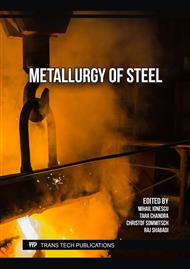[1]
N. Fonstein, Advanced High Strength Sheet Steels, Springer International Publishing, Cham, 2015.
Google Scholar
[2]
J. Speer, D.K. Matlock, B.C. De Cooman, J.G. Schroth, Carbon partitioning into austenite after martensite transformation, Acta Materialia. 51 (2003) 2611–2622.
DOI: 10.1016/s1359-6454(03)00059-4
Google Scholar
[3]
J. Zhao, Z. Jiang, Thermomechanical Processing of Advanced High Strength Steels. Prog. Mater. Sci. 94, (2018), 174–242.
Google Scholar
[4]
B. An, C. Zhang, G. Gao, X. Gui, Z. Tan, R.D.K. Misra, Z. Yang, Experimental and theoretical analysis of multiphase microstructure in a newly designed MnSiCrC quenched and partitioned steel to promote bainitic transformation: The significant impact on mechanical properties, Materials Science and Engineering: A. 757 (2019) 117–123.
DOI: 10.1016/j.msea.2019.04.099
Google Scholar
[5]
V.I. Zurnadzhy, V.G. Efremenko, K.M. Wu, I. Petryshynets, K. Shimizu, A.M. Zusin, M.N. Brykov, V.A. Andilakhai, Tailoring strength/ductility combination in 2.5 wt% Si-alloyed middle carbon steel produced by the two-step Q-P treatment with a prolonged partitioning stage, Materials Science and Engineering: A. 791 (2020) 139721.
DOI: 10.1016/j.msea.2020.139721
Google Scholar
[6]
K. Chen, Z. Jiang, F. Liu, H. Li, C. Kang, W. Zhang, A. Wang, Achievement of High Ductility and Ultra-high Strength of V-Nb Microalloyed Spring Steel by Austempered Multiphase Microstructure, Metallurgical and Materials Transactions A. 51 (2020) 3565–3575.
DOI: 10.1007/s11661-020-05777-2
Google Scholar
[7]
R. Mishnev, Y. Borisova, S. Gaidar, T. Kniaziuk, O. Vagina, R. Kaibyshev, Q&P Response of a Medium Carbon Low Alloy Steel, Metals. 13 (2023) 689.
DOI: 10.3390/met13040689
Google Scholar
[8]
K. Zhang, P. Liu, W. Li, Z. Guo, Y. Rong, Ultrahigh Strength-Ductility Steel Treated by a Novel Quenching–Partitioning–Tempering Process. Mater. Sci. Eng. A. 619 (2014) 205–211.
DOI: 10.1016/j.msea.2014.09.100
Google Scholar
[9]
P.S. Kusakin, R.O. Kaibyshev, High-Mn twinning-induced plasticity steels: Microstructure and mechanical properties. Rev. Adv. Mater. Sci. 44 (2016), 326–360.
Google Scholar
[10]
E.J. Seo, L. Cho, Y. Estrin, B.C. De Cooman, Microstructure-mechanical properties relationships for quenching and partitioning (Q&P) processed steel, Acta Materialia. 113 (2016) 124–139.
DOI: 10.1016/j.actamat.2016.04.048
Google Scholar
[11]
G. Gao, B. Gao, X. Gui, J. Hu, J. He, Z. Tan, B. Bai, Correlation between microstructure and yield strength of as-quenched and Q&P steels with different carbon content (0.06–0.42 wt%C), Materials Science and Engineering: A. 753 (2019) 1–10.
DOI: 10.1016/j.msea.2019.03.018
Google Scholar
[12]
D.P. Koistinen, R.E. Marburger, A general equation prescribing the extent of the austenite-martensite transformation in pure iron-carbon alloys and plain carbon steels, Acta Metallurgica. 7 (1959) 59–60.
DOI: 10.1016/0001-6160(59)90170-1
Google Scholar
[13]
V.G. Gavriljuk, H. Berns, High Nitrogen Steels: Structure, Properties, Manufacture, Applications, Springer Berlin Heidelberg, Berlin, Heidelberg, 1999.
Google Scholar



